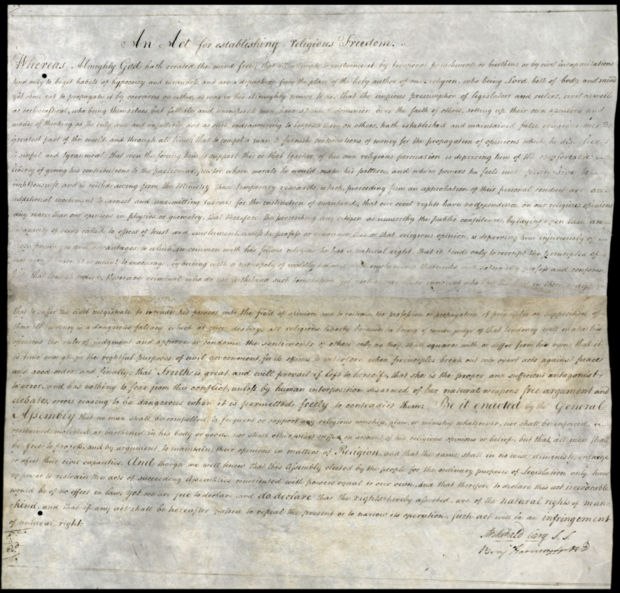Virginia Statute for Religious Freedom
Reading Level: Middle School

Thomas Jefferson. “An Act for Establishing Religious Freedom,” 16 January 1786. Manuscript. Records of the General Assembly, Enrolled Bills, Record Group 78. Lab# 07_0071_01.
“I AM FOR FREEDOM OF RELIGION”
Thomas Jefferson wanted his tombstone to list the most important “things that he had given the people.” It reads:
“Here was buried Thomas Jefferson
Author of the Declaration of Independence
of The Statue of Virginia for Religious Freedom
And Father of the University of Virginia.”
Why did Jefferson, man of many accomplishments, include the Statute for Religious Freedom as one of his gifts to the people?
The Europeans who took the land and founded the colonies were groups seeking religious freedom. At the time, the Church of England was the official religion of Great Britain, and many colonists continued to worship in the Church of England. But people in the thirteen colonies practiced many different religions. There were Baptists, Quakers, Congregationalists, Presbyterians, Jews and Catholics. Thomas Jefferson, like many colonists, believed in “freedom of religion.” Jefferson himself was not very vocal about his own religious beliefs but his ideas developed over time. He was raised Anglican, but he later encouraged the questioning of religious rules and valued reason over fear. More importantly for our country, he thought religion was a “matter between every man and his maker, in which no other, & far less the public, had a right to intermeddle.”
In 1776, when the Colonies declared their independence from Great Britain, delegates met to write state constitutions. The Church of England was closely tied to the British government. Great Britain had imposed taxes to fund the church. Other religious groups did not want to pay taxes to continue to support the Church of England. The new states had to ask the question: should they continue to impose taxes for the support of churches?
Thomas Jefferson believed that people should not be taxed to support any church. He felt there should be a “high wall between church and state.” After returning home from the Second Continental Congress, Jefferson worked to get rid of laws that kept the church in power in Virginia. He had the support of Virginia’s Quakers, Presbyterians and Baptists.
Jefferson wrote the “Bill for Establishing Religious Freedom.” The bill declared that “no man shall be compelled to frequent or support any religious worship, place or ministry whatsoever.” This was a radical idea at the time. In 1779, the bill was introduced to the Virginia Assembly. It did not pass, but it brought together Thomas Jefferson and James Madison. Madison agreed with his fellow Virginian.
Jefferson left for Paris in 1784 to become the US foreign minister to France. It was up to James Madison to get the bill passed. Madison presented the bill to the Virginia Assembly. In 1786, the bill passed with only a few changes. Madison sent word of their triumph to Jefferson in Paris.
With the passing of the bill, Virginia became the first state to separate church and state. It is still part of Virginia’s constitution. It was used as a model for other state’s constitutions. It was also used as a model for the religious language in the Bill of Rights: “Congress shall make no law respecting an establishment of religion, or prohibiting the free exercise thereof.”
Both Thomas Jefferson and James Madison considered the Virginia Statute of Religious Freedom one of their great achievements.

